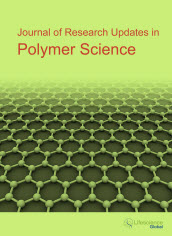jrups
Abstract : Application of Disordered Organic Semiconductor Theory to Low Temperature Curing of Epoxy Resins
|
|
Abstract: The steep autocatalytic feature in a highly accurate DSC study of the heat rate from curing an epoxy resin with piperidine at 27.5 Deg C could not be explained using chemical kinetic power laws usually applied to curing epoxy resin products at higher temperatures. The theory of disordered conjugated organic semiconductors developed in the last decade has been applied to the observed heat rate data. Four heat rate sources have been identified to completely account for the experimental data. Two of the four sources generating 80% of the heat are consistent with mobility change of ion pairs indicating that the low temperature cure follows an organic semiconductor mechanism. It was shown that autocatalysis did not begin until about one fiftieth of the epoxy rings were opened (ignition). After ignition the heat rates of two propagation mechanisms grow exponentially. One charge transport mechanism generates a small heat rate but grows immediately after ignition due to an increase in ion pairs by the dopant (piperidine). The second mechanism appears later but becomes dominant, peaking at 50% completion, where the heat rate is about 50 times higher than the start of the first mechanism. The rate increase is attributed to localized energy sites that lower the LUMO level closer to the HOMO level of the monomer increasing the mobility (heat rate). Keywords: Epoxy resins, kinetics (polym), calorimetry, diffusion, organic semiconductors.Download Full Article |
Abstract : Study on Flexural Strength and Flexural Failure Modes of Carbon Fiber/Epoxy Resin Composites
|
|
Abstract: The flexural failure modes and flexural strength of unidirectional carbon fiber/epoxy (CF/epoxy) composites was theoretically analyzed and calculated. The hypothesis that the maximal flexural strength of unidirectional CF/epoxy composites occurred in outer sheet layer was brought forward. Load-displacement curve of unidirectional CF/epoxy composites also demonstrates that it is correct, which is consistent with the assume. Unidirectional CF/epoxy composites were fabricated with winding and compression molding, and three different kinds of fiber packing modes were proposed and the effects of these modes on flexural prosperities of composites had also been analyzed respectively. Three failure modes, namely fracture of fiber, fracture of epoxy resin and interfacial delamination between fiber and matrix, were analyzed by scanning electron microscopy (SEM). The load-displacement curve of unidirectional CF/epoxy composites indicates the plastic deformation is increased with increasing phenolic resin. Keywords: Bending strength, carbon fiber, packing modes, failure mode, composite.Download Full Article |
Abstract : Structurally Functionalized Polyurethane Foam for Elimination of Lead Ions from Drinking Water
|
|
Abstract: Polyurethane foams functionalized with Sulfonic acid groups have been found to be strong cation exchangers. This novel property of the foam was used to exchange lead (Pb2+) ions from aqueous solutions. Polyurethane foam synthesis is based on addition polymerization of the highly reactive isocyanate (-NCO) groups of an isocyanate with the hydroxyl (–OH) groups of a polyol to form the urethane species. Toluene-2,4-2,6- diisocyanate was reacted with Polypropylene glycol 1200 in 2:1 molar ratio to form a linear pre-polymer. The linear pre-polymer was further polymerized using a chain extender, N, N-bis (2-hydorxyethyl)-2-aminoethane-sulfonic acid (BES). BES also acts as a functional group to exchange Pb2+ ions. A set of experiments were designed to study various process parameters. The functionalized polyurethane foam was characterized by Fourier transform infrared spectroscopy, gel permeation chromatography, scanning electron microscopy, and energy dispersive x-ray spectroscopy. The Pb2+ ion exchange capacity was determined using an Inductively Coupled Plasma Mass Spectrometer. The maximum Pb2+ ion exchange capacity of the foam was found to be 47 parts per billion per gram (ppb/g) from a 100 parts per billion (ppb) Pb2+ solution over a period of 60 minutes. A multistage batch filtration process increased the Pb2+ ion removal to 50-54 ppb/3g of foam over a period of 90 minutes. Keywords: Adsorption, Functionalized, Ion exchange, Polyurethane foams, Sulfonic.Download Full Article |
Abstract : Stick-Slip Transition Behaviour of Two High Density Polyethylene Melts on Capillary Rheometer
|
|
Abstract: The stick-slip transition behaviour of two high density polyethylene (HDPE) melts are studied experimentally by using a capillary rheometer with twin bores at different temperatures. The shear stress-shear rate curves are investigated by the capillary rheometer with two diameters. The results show that the flow curves break at a certain critical shear stress. The broken point of the flow curve implies the occurrence of the stick-slip transition. The critical shear stresses obtained by the two capillaries equal approximately, but extrapolation slip length increases with the diameter of the capillary. It is found that the critical shear stress increases proportionally with absolute temperature, which means increasing temperature can depress or delay the occurrence of slippage to a certain degree. Additionally it is found the slip section’s slope of the shear stress-shear rate curve is lower than the sticky section’s slope. Keywords: Wall slip, critical shear stress, polymer melt, capillary rheometer, slope.Download Full Article |























